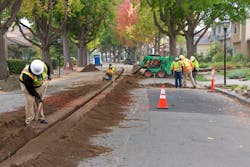PG&E Case Study: Burying Lines to Prevent Wildfires is Cost Effective
Many policymakers and experts continue to speculate on what Pacific Gas & Electric (PG&E) could have done to prevent the fires that have killed more than one hundred people, cost billions of dollars in damages and sent the company into bankruptcy. One of the most common questions asked is why PG&E did not bury its power lines.
The routine answer that it is wildly expensive and customers would never be willing to pay for it. For example, in “Burying PG&E’s Lines to Stop Fires Could Cost $240 Billion” Bloomberg estimates, PG&E would have had to spend the equivalent of $45,000 for every customer to bury the power lines; a number any customer or regulator would balk at funding. This estimate presumes PG&E would have to bury all distribution power lines to eliminate the risk of causing wildfires. In reality, PG&E only needs to underground a portion of its overhead lines. Placing distribution power lines underground in wildfire-prone areas would likely add less than $10 to each customer’s monthly bill; that is not much considering Californians have the fourth lowest electric bills compared to the rest of the country, over $30 less than the national average.
PG&E’s website page on undergrounding costs could easily mislead someone not familiar with the data. The site lists an average cost of $3 million per mile to convert an overhead line to an underground line and PG&E has 81,000 miles of overhead distribution lines in their service area. One could easily assume incorrectly that undergrounding would cost $3 million times 81,000 miles to prevent power lines from starting wildfires or being affected by them. Most of PG&E’s overhead power lines are not in areas prone to wildfires, or as California describes them, High Fire Threat Districts (HFTD). According to PG&E’s “Wildfire Safety Plan” published in 2019, only 25,200 miles of their overhead distribution lines are actually located in HFTD areas.
Most of the lines in the HFTD areas are rural or suburban lines, not urban. The cost to underground lines in these areas is significantly cheaper than in urban areas because of fewer obstacles and more unpaved rights-of-way. PG&E completed two pilot undergrounding projects in the past two years. A 0.5 mile stretch of Bohemian Highway cost about $2.8 million per mile and a 0.66 mile stretch of Fish Ranch Road cost about $1.2 million per mile. The higher cost for the former project was due to steep, forested slopes and a lack of a right-of-way, which forced PG&E to use directional boring directly under the road. These two projects indicate the $3 million per mile average PG&E quotes on its website is significantly higher than the cost to underground lines in the more rural HFTD areas.
PG&E’s undergrounding “facts webpage” states “the main benefits of undergrounding are aesthetic” and “in some scenarios, underground infrastructure can provide improved reliability during storms.” The webpage goes on to say “underground lines are not immune to weather damage and are vulnerable to equipment issues, lightning strikes, flooding, earthquakes and excavation damage by a third party.” These statements are misleading because the reliability of underground lines is actually far superior to overhead lines. The average outage duration a customer experiences on an underground line in the U.S. is typically more than 90% lower than on an overhead line. It is true that underground lines are impacted by outages, but the number of outages is typically far lower than for overhead lines. PG&E mentions these outages can take almost twice as long to repair as overhead repairs; however, power restoration can happen quickly for newer installations because of electronic fault detectors and availability of spare cables.
Another key cost factor not mentioned on the website is the lifetime costs of underground lines versus overhead. While underground lines have a higher, upfront capital cost, they make up for that in many cases with lower maintenance and outage costs over the lifetime of the lines. Exposure to weather conditions causes overhead facilities to corrode and age faster than underground lines. Overhead lines are vulnerable to tree damage, which requires PG&E to periodically trim trees. Animals, mainly squirrels, cause thousands of outages on above-ground facilities every year. Because underground lines have fewer outages, utilities and residential and business customers save money from avoided outages. In California, especially, PG&E would avoid significant costs associated with fire liability. Another key factor in calculating costs is that utilities, like PG&E, use loans to pay for large capital projects that spread the costs over several decades reducing the impact on customer bills. Therefore, the decision to underground lines should not focus on upfront capital costs when the lifetime costs spread over decades are actually more relevant.
PG&E cannot underground lines in one year. A more realistic program would require a multiple-year rollout for the simple reason of a lack of manpower. Factoring in that only 25,200 miles of overhead distribution lines would need to be converted to nearly eliminate the fire hazard, and that costs of converting overhead lines are lower in the HFTD areas, the total cost for burying those lines would likely be closer to $25 billion. However, because underground lines have lower operational and maintenance costs and because converting all the lines would take decades, customers would probably see their monthly bills rise by less than $10. That’s not much considering Californians are now subjected to frequent preventative outages to avoid causing destructive wildfires.
